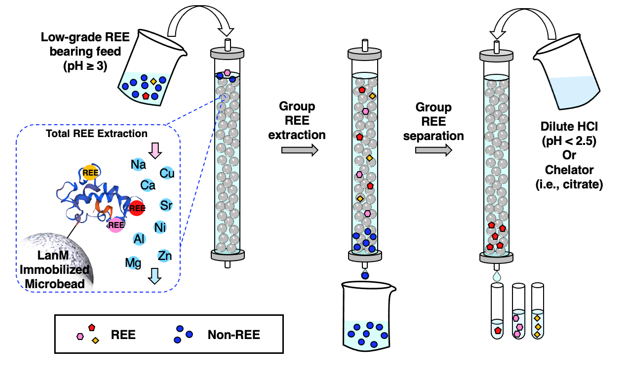Rare earth elements (REEs) are a group of 17 elements consisting of the lanthanide series metals as well as scandium and yttrium. REEs are critical components of many clean energy technologies (e.g., wind turbines and hybrid car batteries) and consumer products (e.g., mobile phones, laptops, appliances, and automotive sensors). As such, constraints or limitations in the supply of REEs could hinder the growth of technology industries that are critical for the transition to a low-carbon economy. Currently REEs are primarily supplied by China; the US imports greater than 80% of its REE demand. To alleviate supply vulnerability and diversify the global REE supply chain, it is imperative to develop new extraction methodologies and explore alternative REE resources and build resilient and sustainable domestic supply chains for REEs. Additionally, recycling these elements is an important aspect of sustainability and cost structure.
The chemical processes currently implemented to extract REEs, purify them against non-REE elements, and separate them from each other are technically complex and environmentally detrimental. Moreover, common hydrometallurgical methods such as solvent extraction or resin extraction require high-grade REE feedstocks. These techniques leverage small molecules (referred to as extractants or ligands) to extract the REEs, but their selectivity is usually limited, which prevents their application to highly variable or diluted REE resources such as electronic waste, REE-containing coals, mine tailings, or geothermal brines. Therefore, there’s a need for separation methods that can be used to target and isolate specific high value REEs.
As an important step toward overcoming the technical and environmental limitations of current REE processing methods, the LLNL team has patented and demonstrated a biobased, all-aqueous REE extraction and separation scheme using the REE-selective lanmodulin protein. Lanmodulin can be fixed onto porous support materials using thiol-maleimide chemistry, which can enable tandem REE purification and separation under flow-through conditions. LLNL researchers have been able to demonstrate the ability of immobilized lanmodulin to achieve high-purity separation of the clean-energy-critical REE pair Nd/Dy and to transform a low-grade leachate (0.043 mol % REEs) into separate heavy and light REE fractions (88 mol % purity of total REEs) in a single column run while using ∼90% of the column capacity.
Additionally, to address shortcomings of using naturally occurring proteins (e.g., LanM, its homologs or engineered versions), LLNL inventors have filed a provisional application that describes a method they have devised to discover natural and engineered proteins with strong intra-group selectivity (e.g., intra-REE, intra-Ni/Co/Cu/Zn). Their approach consists of two assays designed to determine the metal-binding selectivity of several proteins simultaneously: 1) a method for coupling high throughput protein purification with direct REE selectivity determination, and 2) a method where a pool of protein variants is down-selected for those that selectively bind to a target metal on the basis of protection from protein denaturation, degradation and deactivation (e.g., SDS challenge or enzymatic proteolysis). These two methods constitute an invention that enables rapid exploration of any protein sequence space to discover variants with exquisite selectivity for individual REEs and other target metals, thus advancing protein-based metal separation and purification technologies.
Related LLNL technology:
Method of using macromolecules for extraction and purification of rare earth elements
Image Caption: Novel Protein-based Method for REE Separation
Ziye Dong, Joseph A. Mattocks, Jeremy A. Seidel, Joseph A. Cotruvo, Dan M. Park, Protein-based approach for high-purity Sc, Y, and grouped lanthanide separation, Separation and Purification Technology, Volume 333, 125919 (2024).(https://doi.org/10.1016/j.seppur.2023.125919)
Mattocks, J.A., Jung, J.J., Lin, CY. et al. Enhanced rare-earth separation with a metal-sensitive lanmodulin dimer. Nature 618, 87–93 (2023).(https://doi.org/10.1038/s41586-023-05945-5)
Dong, Z., et al., Bridging hydrometallurgy and biochemistry: a protein-based process for recovery and separation of rare earth elements. ACS Cent. Sci. 7, 1798-1808 (2021). (https://doi.org/10.1021/acscentsci.1c00724)
Gauthier J.-P. Deblonde, Joseph A. Mattocks, Dan M. Park, David W. Reed, Joseph A. Cotruvo Jr., and Yongqin Jiao, Selective and Efficient Biomacromolecular Extraction of Rare-Earth Elements using Lanmodulin, Inorganic Chemistry 59 (17), 11855-11867 (2020).(https://doi.org/10.1021/acs.inorgchem.0c01303)
Immobilized lanmodulin maintains the attractive properties of the soluble protein, including remarkable REE selectivity, the ability to bind REEs at low pH, and high stability over numerous low-pH adsorption/desorption cycles.
Key advantages of the protein-based metal separation and purification process outlined in US Patent No. 11,713,493 include:
- the compatibility with low grade feedstock leachates
- the lack of organic solvents and thereby mitigating some of the environmental impacts,
- the ability to achieve high-purity separation of certain REEs while using the entire column capacity.
To advance the separation and purification technologies that utilizes REE binding protein, the benefits of the two-assay approach described in LLNL’s patent application include:
- a rapid method to characterize and screen protein libraries in a high throughput format for members with desirable metal-binding selectivities
- the ability to identify next generation of engineered lanmodulins and other metal-binding proteins with desirable properties such as strong intra-group selectivity (e.g., intra-REE, intra-Ni/Co/Cu/Zn), which is critically important for advancing protein-based metal separation and purification technologies.
This technology has the potential to enable a low-cost recovery and separation process that is broadly applicable to both high and low-grade REE feedstocks:
- Commercial REE extraction- ore and coal mining operations
- Separation of heavier rare earths from lighter rare earths
- Electronic waste recycling
- Geothermal mineral extraction
- Coal byproducts
- Mine tailing
- Holding ponds
To advance the separation and purification technology further, LLNL researchers could apply their novel two-assay approach to the screening the selectivity of natural rare earth element (REE) binding proteins, engineering REE binding proteins for enhanced REE selectivity, as well as de novo design of REE binding proteins.
Current stage of technology development: TRL 2
LLNL has patent(s) on this invention.
US Patent No. 11713493 Compositions and methods of use thereof for rare earth element separation published 8/1/2023


